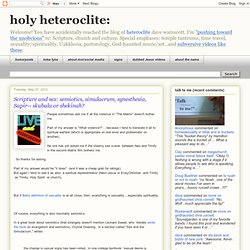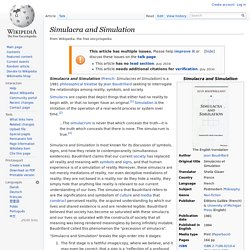

A Life Less Empty - Matrix Wiki - Neo, Trinity, Wachowski Brothers. A Life Less Empty was a comic book story that was part of The Matrix ComicsSeries 1 and Volume 1.

It was written and illustrated by Ted McKeever. Story Edit A story about a hacker extraordinaire named Tiera, who was given the choice of two pills by Morpheus. She chose the blue pill and continues to dwell on and regret it ever afterwards. Characters References See Also. Scripture and sex: semiotics, simulacrum, synesthesia, Sapir. People sometimes ask me if all the violence in "The Matrix" doesn't bother me.

Part of my answer is "What violence? "....because I tend to translate it all to spiritual warfare (which is appropriate on one level and problematic on another). No one has yet asked me if the steamy sex scene between Neo and Trinity in the second Matrix film bothers me. So thanks for asking. Part of my answer would be "it does" (and it was a cheap grab for ratings). But if Bell's definition of sexuality is at all close, then everything is sexuality....especially spirituality.
Of course, everything is also inevitably semiotics. In a great book about semiotics (that strangely doesn't mention Leonard Sweet, who literally wrote the book on evangelism and semiotics), Crystal Downing , in a section called "Sex and the Simulacrum," writes: the change in sexual signs has been noted...in one college textbook: 'sexual desire is no longer a response to a person whom we meet and know face-to-face. Huh? Or to Jesus, Simulacra and Simulation - Matrix Wiki - Neo, Trinity, Wachowski Brothers.
Simulacra and Simulation (Simulacres et Simulation in French), published in 1981, is a philosophical treatise by Jean Baudrillard.

The Matrix Comics - Matrix Wiki - Neo, Trinity, Wachowski Brothers. The Matrix Comics refer to a group of short stories, comics and pin-ups set in the Matrix universe.

They were originally published on the official Matrix website from 1999 to 2003 as three series of webcomics with additional pieces of artwork, most of which were later collected into two volumes, published by the Wachowski Brothers' company Burlyman Entertainment along with three comics never released on the internet. The comics' editor was Spencer Lamm.
The Wachowski Brothers contributed one script to the project, Bits and Pieces of Information, aspects of which were later included in The Animatrix short animated film The Second Renaissance. In addition, a number of the comics were printed individually in comic books: Most but not all of the stories have the protagonists, bluepills and redpills alike, end up dead or in awkward situations. Pin-ups Edit External links. Caciula Beanie MP3 Player – 2GB. The MATRIX 101 - Understanding The Books - The Matrix Comics Volume 1. Paperback: 160 pagesIntroduction by Spencer LammStories and Art by Andy & Larry Wachowski, Geof Darrow, Bill Sienkiewicz, Neil Gaiman, Ted McKeever, John Van Fleet, Dave Gibbons, David Lapham, Peter Bagge, Troy Nixey, Paul Chadwick, Ryder Windham, Kilian Plunkett, Gregory Ruth The Matrix Comics, Volume 1 is a paperback collection of 12 of the online comics that have been published on the official Matrix site since 1999.

You can still read these comics online, but the Wachowskis responded to consumer demand for a hardcopy by printing The Matrix Comics themselves, ensuring the same high level of quality you've come to expect from all things Matrix. The 12 stories reproduced here are selected from each of the three comic series that have been published online.
There's early indication that we could see a volume 2, 3, even 4 over the next several years...and make no mistake, seeing future volumes of The Matrix Comics in print would be a very good thing. Simulacra and Simulation. Simulacra and Simulation (French: Simulacres et Simulation) is a 1981 philosophical treatise by Jean Baudrillard seeking to interrogate the relationships among reality, symbols, and society.

Simulacra are copies that depict things that either had no reality to begin with, or that no longer have an original.[1] Simulation is the imitation of the operation of a real-world process or system over time.[2] ...The simulacrum is never that which conceals the truth—it is the truth which conceals that there is none. The simulacrum is true.[3] "Simulacra and Simulation" breaks the sign-order into 4 stages: Simulacra and Simulation identifies three types of simulacra and identifies each with a historical period: First order, associated with the premodern period, where representation is clearly an artificial placemarker for the real item. Baudrillard theorizes that the lack of distinctions between reality and simulacra originates in several phenomena:[7] See also[edit] [edit]